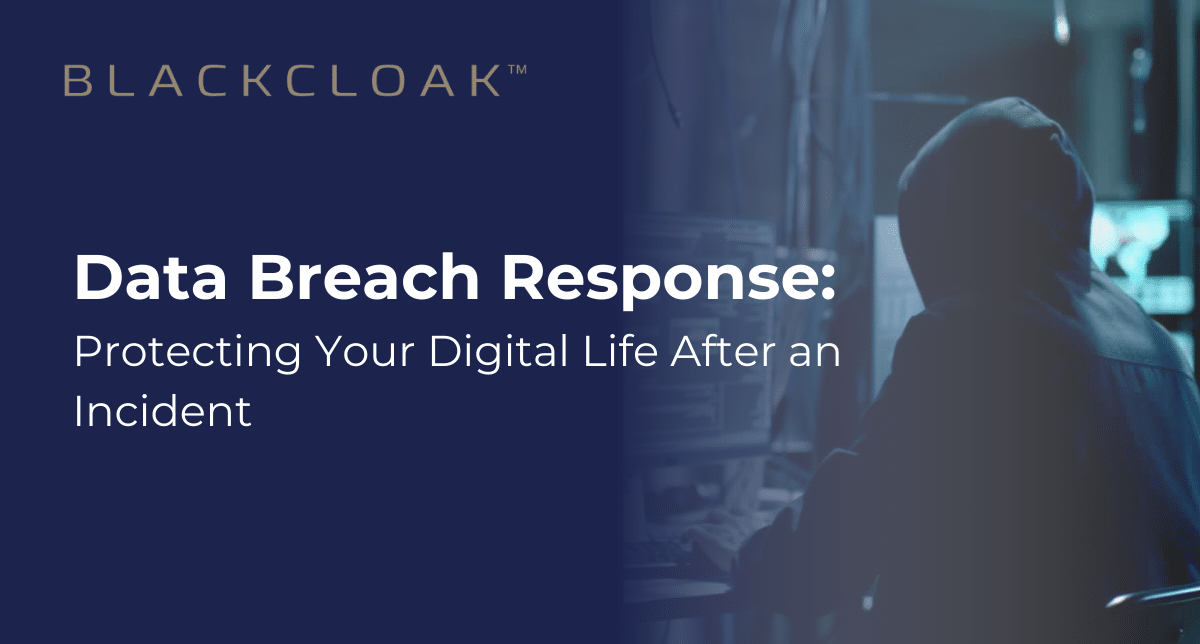Data Breach Response: Protecting Your Digital Life After an Incident

Discovering that a company with which you’ve shared your personal data has fallen victim to a cyber attack is a sobering experience. Unfortunately, in this era of relentless cyber threats, it’s becoming increasingly common. So, what is the appropriate data breach response following a data security incident?
Has My Data Been Breached?
If you’re concerned your data may have been exposed in a breach, here are some key steps you can take to find out quickly and take action:
- Check Breach Notification Emails
- Companies are legally required to notify users if their data has been compromised. Look for any official emails from services you use that may have been affected.
- Ensure the email is legitimate to avoid phishing scams.
- Use Data Breach Checkers
- Personal cybersecurity services with dark web scanning allow you to check if your email or personal information has appeared in known breaches.
- Regularly Monitor Your Accounts
- Review recent transactions or activities in your bank, credit card, and social media accounts for any unauthorized access.
- Enroll in an Identity Theft Protection and Credit Monitoring program.
- Set Up Alerts
- Many credit bureaus and financial institutions offer free alert services to notify you of suspicious activity, like new credit accounts opened in your name.
- Enroll in these services to catch fraudulent activity early.
- Check with Companies
- If you believe a specific service was affected, visit their website or contact customer support for updates on any breaches. Often, they’ll provide additional guidance on what steps you can take.
What is the Leading Cause of a Data Breach?
The leading cause of a data breach is typically businesses’ failure to adequately protect sensitive information, not the fault of customers. While individuals should take steps to safeguard their personal data, the responsibility primarily lies with companies to secure the vast amounts of data they collect.
Here are some common causes directly related to business vulnerabilities:
- Weak Security Infrastructure: Poorly configured firewalls, outdated software, or lack of encryption are often exploited by attackers.
- Insider Threats: Employees, contractors, or vendors with access to sensitive data can unintentionally or maliciously cause data breaches.
- Unpatched Software and Systems: When businesses don’t update their software with the latest security patches, they leave themselves vulnerable to attacks exploiting known weaknesses.
- Third-Party Vendors: Companies often work with third-party vendors, but if those vendors don’t have robust security protocols in place, they can become a weak link in the supply chain.
- Social Engineering Attacks: Phishing scams and other forms of social engineering trick employees into divulging sensitive information or giving hackers access to company systems.
How to Understand the Risk Level of Your Recent Data Breach
The appropriate data breach response plan largely depends on the nature of the breached data and the type of website from which it was stolen. Websites and the data they handle can be categorized into high, moderate, and low risk.
High Risk: If these sites are breached, your social security number, bank account details, health records, or even control of your home devices could be compromised. These include:
- Financial institutions
- Email providers
- Social media platforms
- Healthcare providers
- Any site controlling internet-connected devices like home cameras or voice-controlled devices
Recent examples include the national public data breach and the UnitedHealth Group data breach. If you are victim of high-level data breaches such as these, it’s important to seek immediate action. Review the Data Breach Response Plan Checklist below.
Moderate Risk: These are sites that have more in-depth records about you or your family. These may provide hackers a foothold to obtain more valuable information—and they may let thieves know when you will be away from home, leaving your valuables or loved ones at risk. Examples include:
- Location-sharing apps
- Hotel or airline booking platforms
- Any sites that store your travel information and preferences
Low Risk: These are generally retail sites that mainly hold your name and email address. While there is no such thing as a truly low- or no-risk data breach, these issues may only require monitoring and maintaining cybersecurity best practices.
Your Data Breach Response Plan Checklist
If you find out your data has been compromised in a breach, follow these steps to minimize potential damage:
- Change Your Passwords: Immediately log in to the breached website and change your password. If possible, enable two-factor authentication for added security.
- Review Your Account Information: Examine your account details to ascertain what data might have been compromised.
- File an ID Theft Affidavit (for high-risk breaches): If a high-risk website is breached, file an ID theft affidavit with the FTC and place a fraud alert on your accounts.
- Alert the Authorities: If your social security number was potentially exposed, inform the IRS and your accountant. For passport data, contact the State Department.
- Monitor Your Credit Report: Regularly review your credit reports for any unauthorized activities or changes.
- Contact Your Bank (for financial data breaches): If a financial account or credit/debit card was compromised, contact your bank immediately, request new card numbers, and monitor your account for any suspicious activity.
- Watch Your Mail: Be vigilant for any new accounts, cards, or suspicious activities opened in your name.
- Take Advantage of Credit Monitoring: If the breached company offers credit monitoring services, consider using them to keep a close eye on your credit activity.
BlackCloak: Data Breach Response Services for Executives & HNWIs
A data breach can be stressful, but with the right data breach response services, you can minimize the damage and regain control over your digital life. But remember–cybersecurity isn’t just about preventing breaches; it’s about having a solid plan in place if one occurs. At BlackCloak, our mission is to guide you in protecting your digital life, no matter the circumstances. Together, we can ensure that your digital life remains secure.








